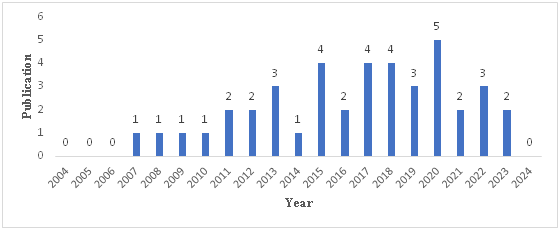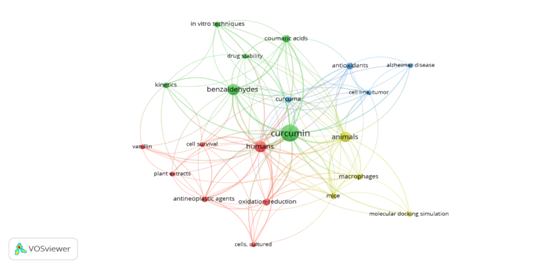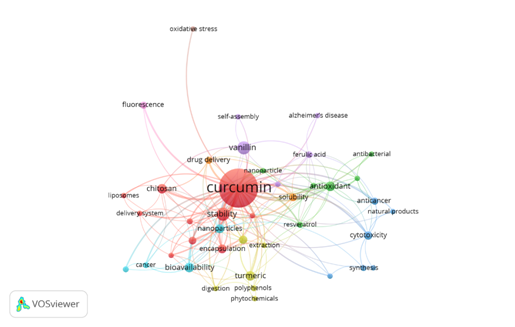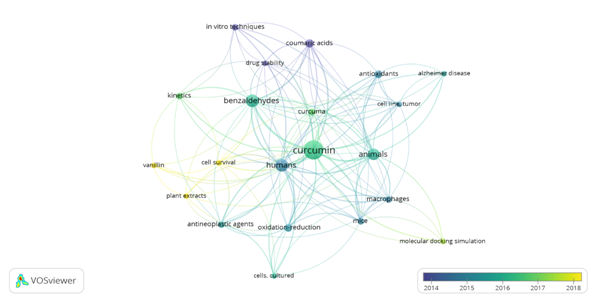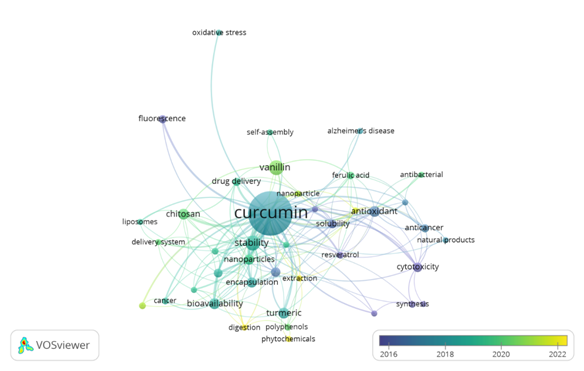Curcumin as A Vanillin Source: Bibliometric Review
- Riyana Sunardi
- Tuty Anggraini
- Fauzan Azima
- 409-418
- Aug 2, 2024
- Food Science
Curcumin as a Vanillin Source: Bibliometric Review
Riyana Sunardi, Tuty Anggraini, Fauzan Azima
Department of Food Technology and Agricultural Product, Faculty of Agricultural Technology, Andalas University
DOI: https://doi.org/10.51244/IJRSI.2024.1107030
Received: 24 June 2024; Revised: 05 July 2024; Accepted: 09 July 2024; Published: 02 August 2024
ABSTRACT
Curcumin has long been used in various aspects of human life as a spice, food coloring, skin care products, and traditional medicine because of its trusted antioxidant properties. However, curcumin has low stability, especially in neutral to alkaline solutions, which causes the potential for forming other compounds in the form of vanillin. Not much bibliometric research has been carried out regarding curcumin as a source of vanillin. Therefore, to understand research trends, knowledge insights, and future research objectives, this paper attempts to provide a bibliometric analysis of curcumin as a source of vanillin. By using relevant keywords, research data was collected from the Pubmed and Sciencedirect database. Bibliometric analysis was performed to understand publication overlays, keyword networks, and publication patterns. Analysis of the findings shows that between 2018 and 2021, there was an increase in interest in curcumin and its benefits—including as a source of vanillin. Further research is needed to provide insight into the degradation of curcumin to vanillin.
Keywords: curcumin, turmeric, vanillin production, bibliometric, VOSviewer
INTRODUCTION
Curcumin has a long history of safe use in human life. Curcumin has traditionally been used as a spice component in food, food coloring, and textile dye. Besides that, curcumin has long been used in skin care products and traditional medicine because of its properties, which are believed to improve health due to its antioxidant properties. Apart from antioxidant activity, curcumin also has other properties such as anti-inflammatory, antiproliferative, anti-angiogenic, and antibacterial (Kumar et al., 2016; Murray-Stewart et al., 2018). The following is a table containing a brief overview of topics that discuss the health benefits of curcumin:
Table 1. Health benefits of curcumin compounds
| Curcumin’s benefits | References |
| Enhanced antioxidant, anti-inflammatory, anticancer, antimicrobial, antidiabetic properties, hepatoprotective, gastroprotective, neuroprotective, cardioprotective and osteogenesis efficacy. | (Prasad & Lall, 2022) |
| Induce apoptosis in the three types of urological cancers | (Hashemi et al., 2022) |
| Effective for ulcerative colitis | (Yin et al., 2022) |
| Reduce cardiovascular risk | (An et al., 2022) |
| Useful for longevity via declining of oxidative stress, modulating signal transduction, and gene expression | (Zia et al., 2021) |
| Reducing exercise-induced muscle damage | (Nanavati et al., 2022) |
| Anti-aging properties | (Izadi et al., 2024) |
| Therapeutic agent | (Yallapu et al., 2015) |
| Prevent brain disease | (Del Prado-Audelo et al., 2019) |
| Antimycobacterial agent | (Barua & Buragohain, 2021) |
| Preventive and curative effects on oxidative stress, inflammation, and apoptosis in non-cancerous diseases and cancers | (Hu et al., 2023) |
| Cardiometabolic Health and Dementia | (Kim & Clifton, 2018) |
| Anticancer agents | (Tomeh et al., 2019) |
| Associated with gut microbiota | (Pluta et al., 2020) |
| Eye diseases treatment | (Kao et al., 2021) |
| Anti-obesity | (Kasprzak-Drozd et al., 2022) |
| Ameliorate obesity and metabolic dysfunction in diet-induced obese animal models | (Moetlediwa et al., 2023) |
| Central nervous system (CNS)-related diseases treatment including Parkinson’s disease, Huntington disease, Alzheimer’s disease, Multiple sclerosis, epilepsy and Amyotrophic Lateral Sclerosis. | (Yavarpour-Bali et al., 2019) |
| For the treatment of osteopenia | (Gorabi et al., 2019) |
| Cancer therapy | (Trošelj et al., 2020) |
| Anti-atherosclerotic | (Singh et al., 2021) |
| Potential for antiviral therapeutic | (Ardebili et al., 2021) |
| Therapeutic potential in inflammatory diseases such as neurodegenerative diseases, respiratory diseases, and arthritis | (Benameur et al., 2023) |
| Gastrointestinal disease treatment | (Ji et al., 2024) |
| Microbiome effects, Antioxidant effects, Intestinal permeability effects, Anti-bacterial, anti-parasitic, anti-fungal effects, Anti- inflammatory and immune effects | (Lopresti, 2018) |
| Prevention and Treatment for Type 2 Diabetes Mellitus | (Pivari et al., 2019) |
| Therapeutic Effects in Lung Cancer | (Nur et al., 2019) |
| Influence the gut microbiota | (Scazzocchio et al., 2020) |
| Neuroprotective against environmental toxic agents | (Filardi et al., 2020) |
| Anticancer | (Wong et al., 2021) |
| Nanocurcumin seem to give the best effects on gut microbiota | (Jabczyk et al., 2021) |
| Therapeutic Agent for Sarcopenia Siti | (Gany et al., 2023) |
| Effectively relieve anxiety-like behaviors caused by DSS (sulfate sodium salt) in mice | (Zhang et al., 2022) |
| Stabilization of sperm chromatin | (Tvrdá et al., 2021) |
| Mediated inhibition of androgen and estrogen for against tumors affecting the reproductive system in females and males | (Mohajeri et al., 2020) |
| Exhibits a spermicidal and broad-spectrum microbicidal activity against several species of bacteria and yeast involved in vaginal infections | (Naz et al., 2016) |
| May have favorable effects on C-reactive protein, malondialdehyde, and nitric oxide in subjects with cigarette smoking | (Mamsharifi et al., 2023) |
| Boosts DHA in the brain | (Wu et al., 2016) |
Curcuminoids are a group of compounds that are naturally contained in turmeric rhizomes. This curcuminoid is contained in turmeric rhizomes around 5% of its dry weight. The crude extract contained in turmeric contains three main curcuminoid compounds, namely curcumin (1,7-bis(4-hydroxy-3-methoxy-yphenyl)-1,6-heptadiene-3,5-dione) which contains 60-70 %, desmethoxycurcumin around 20–27%, and bisdemethoxycurcumin as much as 10–15%. Furthermore, other secondary metabolites remain in smaller amounts. Curcumin plays a role in the characteristic yellow-orange color and spice taste of turmeric (Murray-Stewart et al., 2018; Nelson et al., 2017).
Curcumin is a relatively unstable compound and degrades rapidly in neutral to alkaline solutions. Curcumin has poor metabolic and chemical stability, making it difficult to determine whether the observed anticancer effects are mediated by curcumin by curcumin itself or its metabolites. In addition to its poor metabolic stability, the chemical stability of curcumin is also poor. Curcumin is rapidly degraded in aqueous solutions at physiological pH with a half-life of several minutes. This leads to the rapid formation of two degradation products: alkaline hydrolysis and autoxidation. Curcumin is degraded to form other compound products, including ferulic acid, feruloyl methane, and vanillin (Zhu et al., 2017).
Several mechanisms have been discovered to degrade curcumin into vanillin. It has been proven that heating, exposure to visible light, and with the help of microwave-induced bismuth nitrate can degrade curcumin to vanillin. In addition, degradation can be carried out by microbes, such as enzymes produced by the family of fungi and Rhodococcus rhodochrous bacteria (Bandyopadhyay & Banik, 2012; Esparan et al., 2015; Hofmann et al., 2023; Nagpure & Gupta, 2011; Siddiqui, 2015; Tsuda, 2018)
Turmeric is a source of curcumin, which is very easy to find worldwide. Turmeric is an annual herbaceous plant belonging to the Zingiberaceae family. This plant is found in India, Southeast Asian countries, and parts of Australia. This plant is widely cultivated in tropical countries such as India, Pakistan, Myanmar, and others, and India alone accounts for 80% of global turmeric production. The abundant availability of turmeric causes the selling price to be low. This is in contrast to the source of the vanillin compound, namely Vanilla planifolia. The vanilla plant faces challenges in terms of cultivation due to its narrow genetic base, so this plant experiences scarcity, causing high selling prices. This is a reason to look for alternative sources of vanillin production, one of which is curcumin contained in turmeric rhizomes (Deb & Chakraborty, 2017; Monja-Mio et al., 2019; Padma et al., 2016).
Many studies have proven that curcumin from turmeric rhizomes has health benefits and is useful as a source of ingredients for producing the flavor compound, namely vanillin. However, there has been no bibliometric research on this topic. Therefore, conducting a bibliometric study of curcumin as a source of vanillin is necessary to understand the scope of further research and provide future research directions.
The bibliography provides analytical results regarding valuable insights, including research trends, gaps, and future research directions. This analysis can help recognize the impact of scientific results, determine research directions, and understand technological developments in various fields. Bibliographic analysis helps identify the most studied topics, current issues, and research trends that measure and visualize qualitative data. Overall, bibliographic analysis is important in guiding researchers to gain new research insights, avoid plagiarism, use resources effectively, and highlight limitations researchers should be aware of (Abdullah et al., 2023; Şenyapar, 2023).
MATERIALS AND METHOD
Data Sources
Literature data on ginger as a medicinal plant is obtained from the Pubmed and Sciencedirect database. References to Curcumin as a Vanillin source are taken from the Pubmed and Sciencedirect database because it has more comprehensive and extensive data. The keywords used in the Scopus database are “curcumin” OR “turmeric” OR “vanillin” OR “flavor”. Scientific literature contains either one of the keywords, terms, or phrases in the title, abstract, article, or keywords. The scientific literature used is from the last 20 years (2004-2024) and is limited to English-language publications.
Data Extraction and Analysis
Data analysis and extraction were carried out by combining existing scientific literature information, including titles, abstracts, keywords, and relevant articles. After the data is extracted, analysis is carried out to understand and analyze the collected data. The collected literature is saved in “.txt” format for Pubmed database and in “.ris” for Sciencedirect database. The data was then exported to Vosviewer version 1.6.20 for further bibliometric analysis (van Eck and Waltman, 2020). The parameters used for the results include publication trends, analysis of contributing publishers, keyword co-occurrence network, and overlay. Data extraction and analysis are described in Fig.1.
Term Map
VOSViewer is open-access software that is widely used for bibliometric analysis, including for creating bibliometric maps to visualize the structure and evolution of knowledge in various scientific disciplines. This software helps create keyword maps, identify clusters, and analyze trends in research fields based on the co-occurrence of terms. VOSViewer helps find accurate search keywords, identifying collaboration partners, seminal papers, and knowledge gaps in the scientific landscape. Through the VOSviewer application, bibliometric mapping visualizations can be seen, including network patterns or relationships between data; visualizations are displayed in 3 categories, namely network visualizations, which can display the level of strength of relationships between terms; overlay visualizations, which can display mapping based on the year the article was published, and visualizations. Density can display the density of the research group (Putri et al., 2023; Zakiyyah et al., 2022).
RESULTS AND DISCUSSION
Publication Trends
The latest research data collected and stored until May 18, 2024, comes from the Pubmed database. The graph in Fig. 1 shows the publication trend in the last 20 years, from 2004 to 2024. The number of publications on curcumin about vanillin varies from year to year. Publications on the topic of curcumin and its benefits tend to increase from 2017 to 2020. This trend indicates increased interest in using curcumin and its benefits, including as a source for producing the flavor compound vanillin. This is thought to be the result of the abundance of turmeric as a source of curcumin compounds so that it can reduce production capital and is related to its health benefits.
Fig. 1. Publication trends regarding curcumin and its benefits with the keyword “vanillin production from curcumin”
Keyword Co-occurrence Network and Overlay
Fig. 2. Keyword co-occurrence network from Pubmed database
Based on the search terms used, it can be seen in the visual representation in Fig. 2 that curcumin is associated with various healthful properties for humans and other compounds, one of which is vanillin. Curcumin has the largest bubble size in the mapping, followed by bubbles representing humans. This shows that much research has discussed the benefits of curcumin on human health. Curcumin is reported to be beneficial for humans as an antioxidant anti-tumor, and is associated with preventing Alzheimer’s disease (Kocaadam & Şanlier, 2017). Meanwhile, there has not been much discussion regarding curcumin’s ability to degrade into other compounds such as vanillin. This can be seen from the size of the map bubble representing vanillin, which is quite small. The bubble map of vanillin is connected to the bubble map of curcumin, which explains that this topic has been discussed but not many.
Fig. 3. Keyword co-occurrence network from Sciencedirect database
Based on the search terms used, it can be seen in the visual representation in Figure 3 that curcumin is associated with its benefits as an anti-cancer and antioxidant. Apart from its benefits, curcumin is also discussed regarding its stability, solubility, and degradation products such as ferulic acid and vanillin. Curcumin has the largest bubble size in the mapping, followed by the bubble representing humans. This indicates that many studies have discussed the benefits of curcumin for human health. However, there has not been much discussion regarding curcumin’s ability to break down into other compounds such as vanillin. This can be seen from the size of the map bubble representing vanillin, which is small. The vanillin bubble map is connected to the curcumin bubble map, which explains that this topic has been discussed before but not much.
Figure 4. Keyword co-occurrence overlay from Pubmed database with a time frame
Based on the visualization of the research results seen in Figure 4, it is reported that the research trend for curcumin as a source of vanillin in 2004-2024 was carried out predominantly in the 2016-2018 period. This is indicated by the bluish-green to yellow color on the bubble map. Meanwhile, the purple bubble shows that the research has been carried out for a long time. The novelty of the research field on this topic is considered unexplored. This is reflected in the yellow color on the bubble map which indicates that this research was carried out around 2018 which is relatively new.
Figure 5. Keyword co-occurrence overlay from Sciencedirect database with a time frame
Based on the visualization of research results seen in Figure 5, it is reported that the trend of research on curcumin as a source of vanillin in 2004-2024 was mostly carried out in the 2020-2021 period. This is indicated by the bright green color on the vanillin bubble map. Meanwhile, purple bubbles indicate that the research has been carried out for a long time. This shows that the topic of curcumin in relation to vanillin is still relatively new.
CONCLUSION
This study presents a bibliometric analysis of the use of curcumin as vanillin in the food and beverage industry as well as additional information regarding its potential health benefits. Data was collected from Pubmed and Sciencedirect which focuses on scientific literature from the last 20 years. The results of the analysis show that there is a trend of increasing interest in research related to curcumin, especially from 2018 to 2021. This indicates increasing interest in the use of curcumin as a source of vanillin and the health benefits of curcumin. Although curcumin has been widely discussed in the literature regarding its health benefits, little has been discussed about its ability to convert into other compounds such as vanillin. The term network visualization indicates that research on the health benefits of curcumin predominates over research on its use as a source of vanillin. In addition, analysis of the overlay by year shows that research on curcumin as a source of vanillin is still relatively new in 2018, thus indicating the potential for further research on this topic.
REFERENCES
- Abdullah, K. H., Roslan, M. F., & Ishak, N. S. (2023). Unearthing Hidden Research Opportunities Through Bibliometric Analysis: A Review. Asian Journal of Research in Education and Social Sciences, 5(1), 251–262. https://doi.org/10.55057/ajress.2023.5.1.23
- An, P., Wan, S., Luo, Y., Luo, J., Zhang, X., Zhou, S., Xu, T., He, J., Mechanick, J. I., Wu, W. C., Ren, F., & Liu, S. (2022). Micronutrient Supplementation to Reduce Cardiovascular Risk. Journal of the American College of Cardiology, 80(24), 2269–2285. https://doi.org/10.1016/j.jacc.2022.09.048
- Ardebili, A., Pouriayevali, M. H., Aleshikh, S., Zahani, M., Ajorloo, M., Izanloo, A., Siyadatpanah, A., Nikoo, H. R., Wilairatana, P., & Coutinho, H. D. M. (2021). Antiviral therapeutic potential of curcumin: An update. Molecules, 26(22), 1–23. https://doi.org/10.3390/molecules26226994
- Bandyopadhyay, D., & Banik, B. K. (2012). Bismuth nitrate-induced microwave-assisted expeditious synthesis of vanillin from curcumin. Organic and Medicinal Chemistry Letters, 2(1), 15. https://doi.org/10.1186/2191-2858-2-15
- Barua, N., & Buragohain, A. K. (2021). Therapeutic potential of curcumin as an antimycobacterial agent. Biomolecules, 11(9), 1–13. https://doi.org/10.3390/biom11091278
- Benameur, T., Frota Gaban, S. V., Giacomucci, G., Filannino, F. M., Trotta, T., Polito, R., Messina, G., Porro, C., & Panaro, M. A. (2023). The Effects of Curcumin on Inflammasome: Latest Update. Molecules, 28(2), 1–19. https://doi.org/10.3390/molecules28020742
- Deb, B. C., & Chakraborty, S. (2017). Evaluation of Genetic Variability and Characterization of Some Elite Turmeric Genotypes in Terai Region in India. International Journal of Current Microbiology and Applied Sciences, 6(5), 2357–2366. https://doi.org/10.20546/ijcmas.2017.605.264
- Del Prado-Audelo, M. L., Caballero-Florán, I. H., Meza-Toledo, J. A., Mendoza-Muñoz, N., González-Torres, M., Florán, B., Cortés, H., & Leyva-Gómez, G. (2019). Formulations of curcumin nanoparticles for brain diseases. Biomolecules, 9(2), 1–28. https://doi.org/10.3390/biom9020056
- Esparan, V., Krings, U., Struch, M., & Berger, R. G. (2015). A three-enzyme-system to degrade curcumin to natural vanillin. Molecules, 20(4), 6640–6653. https://doi.org/10.3390/molecules20046640
- Filardi, T., Varì, R., Ferretti, E., Zicari, A., Morano, S., & Santangelo, C. (2020). Curcumin: Could this compound be useful in pregnancy and pregnancy-related complications? Nutrients, 12(10), 1–20. https://doi.org/10.3390/nu12103179
- Gany, S. L. S., Chin, K. Y., Tan, J. K., Aminuddin, A., & Makpol, S. (2023). Curcumin as a Therapeutic Agent for Sarcopenia. Nutrients, 15(11). https://doi.org/10.3390/nu15112526
- Gorabi, A. M., Kiaie, N., Hajighasemi, S., Jamialahmadi, T., Majeed, M., & Sahebkar, A. (2019). The effect of curcumin on the differentiation of mesenchymal stem cells into mesodermal lineage. Molecules, 24(22), 1–19. https://doi.org/10.3390/molecules24224029
- Hashemi, M., Mirzaei, S., Barati, M., Hejazi, E. S., Kakavand, A., Entezari, M., Salimimoghadam, S., Kalbasi, A., Rashidi, M., Taheriazam, A., & Sethi, G. (2022). Curcumin in the treatment of urological cancers: Therapeutic targets, challenges and prospects. Life Sciences, 309(July), 120984. https://doi.org/10.1016/j.lfs.2022.120984
- Hofmann, E., Degot, P., Touraud, D., König, B., & Kunz, W. (2023). Novel green production of natural-like vanilla extract from curcuminoids. Food Chemistry, 417(March). https://doi.org/10.1016/j.foodchem.2023.135944
- Hu, P., Li, K., Peng, X. X., Kan, Y., Yao, T. J., Wang, Z. Y., Li, Z., Liu, H. Y., & Cai, D. (2023). Curcumin derived from medicinal homologous foods: its main signals in immunoregulation of oxidative stress, inflammation, and apoptosis. Frontiers in Immunology, 14(July), 1–7. https://doi.org/10.3389/fimmu.2023.1233652
- Izadi, M., Sadri, N., Abdi, A., Zadeh, M. M. R., jalaei, D., Ghazimoradi, M. M., Shouri, S., & Tahmasebi, S. (2024). Longevity and anti-aging effects of curcumin supplementation. GeroScience, 46(3), 2933–2950. https://doi.org/10.1007/s11357-024-01092-5
- Jabczyk, M., Nowak, J., Hudzik, B., & Zubelewicz-Szkodzińska, B. (2021). Curcumin and its potential impact on microbiota. Nutrients, 13(6), 1–12. https://doi.org/10.3390/nu13062004
- Ji, J., Ma, Z., & Wang, Y. (2024). Advancing Gastrointestinal Health: Curcumin’s Efficacy and Nanopreparations. Molecules, 29(7), 1–16. https://doi.org/10.3390/molecules29071659
- Kao, Y. W., Hsu, S. K., Chen, J. Y. F., Lin, I. L., Chen, K. J., Lee, P. Y., Ng, H. S., Chiu, C. C., & Cheng, K. C. (2021). Curcumin metabolite tetrahydrocurcumin in the treatment of eye diseases. International Journal of Molecular Sciences, 22(1), 1–18. https://doi.org/10.3390/ijms22010212
- Kasprzak-Drozd, K., Oniszczuk, T., Gancarz, M., Kondracka, A., Rusinek, R., & Oniszczuk, A. (2022). Curcumin and Weight Loss: Does It Work? International Journal of Molecular Sciences, 23(2). https://doi.org/10.3390/ijms23020639
- Kim, Y., & Clifton, P. (2018). Curcumin, cardiometabolic health and dementia. International Journal of Environmental Research and Public Health, 15(10), 1–34. https://doi.org/10.3390/ijerph15102093
- Kocaadam, B., & Şanlier, N. (2017). Curcumin , an active component of turmeric ( Curcuma longa ), and its effects on health. Critical Reviews in Food Science and Nutrition, 8398. https://doi.org/10.1080/10408398.2015.1077195
- Kumar, G., Mittal, S., Sak, K., & Tuli, H. S. (2016). Molecular mechanisms underlying chemopreventive potential of curcumin: Current challenges and future perspectives. Life Sciences, 148, 313–328. https://doi.org/10.1016/j.lfs.2016.02.022
- Lopresti, A. L. (2018). The problem of curcumin and its bioavailability: Could its gastrointestinal influence contribute to its overall health-enhancing effects? Advances in Nutrition, 9(1), 41–50. https://doi.org/10.1093/advances/nmx011
- Mamsharifi, P., Farokhi, B., Hajipoor-Taziani, R., Alemi, F., Hazegh, P., Masoumzadeh, S., Jafari, L., Ghaderi, A., & Ghadami Dehkohneh, S. (2023). Nano-curcumin effects on nicotine dependence, depression, anxiety and metabolic parameters in smokers: A randomized double-blind clinical study. Heliyon, 9(11), e21249. https://doi.org/10.1016/j.heliyon.2023.e21249
- Moetlediwa, M. T., Ramashia, R., Pheiffer, C., Titinchi, S. J. J., Mazibuko-Mbeje, S. E., & Jack, B. U. (2023). Therapeutic Effects of Curcumin Derivatives against Obesity and Associated Metabolic Complications: A Review of In Vitro and In Vivo Studies. International Journal of Molecular Sciences, 24(18). https://doi.org/10.3390/ijms241814366
- Mohajeri, M., Bianconi, V., Ávila-Rodriguez, M. F., Barreto, G. E., Jamialahmadi, T., Pirro, M., & Sahebkar, A. (2020). Curcumin: a phytochemical modulator of estrogens and androgens in tumors of the reproductive system. Pharmacological Research, 156(March), 104765. https://doi.org/10.1016/j.phrs.2020.104765
- Monja-Mio, K. M., Herrera-Alamillo, M. A., Sánchez-Teyer, L. F., & Robert, M. L. (2019). Breeding strategies to improve production of agave (Agave spp.). In Advances in Plant Breeding Strategies: Industrial and Food Crops (Vol. 6). https://doi.org/10.1007/978-3-030-23265-8_10
- Murray-Stewart, T., Dunworth, M., Lui, Y., Giardiello, F. M., Woster, P. M., & Casero, R. A. (2018). Curcumin mediates polyamine metabolism and sensitizes gastrointestinal cancer cells to antitumor polyamine-targeted therapies. PLoS ONE, 13(8), 1–23. https://doi.org/10.1371/journal.pone.0202677
- Nagpure, B. A. A. L., & Gupta, R. K. (2011). Biotransformation of curcumin to vanillin. Indian Journal of Chemistry – Section B Organic and Medicinal Chemistry, 50(8), 1119–1122.
- Nanavati, K., Rutherfurd-Markwick, K., Lee, S. J., Bishop, N. C., & Ali, A. (2022). Effect of curcumin supplementation on exercise-induced muscle damage: a narrative review. European Journal of Nutrition, 61(8), 3835–3855. https://doi.org/10.1007/s00394-022-02943-7
- Naz, R. K., Lough, M. L., & Barthelmess, E. K. (2016). Curcumin: A novel non-steroidal contraceptive with antimicrobial properties. Frontiers in Bioscience – Elite, 8(1), 113–128. https://doi.org/10.2741/e755
- Nelson, K. M., Dahlin, J. L., Bisson, J., Graham, J., Pauli, G. F., & Walters, M. A. (2017). The Essential Medicinal Chemistry of Curcumin. Journal of Medicinal Chemistry, 60(5), 1620–1637. https://doi.org/10.1021/acs.jmedchem.6b00975
- Nur, W., Wan, B., Tajuddin, M., Lajis, N. H., Abas, F., & Othman, I. (2019). Mechanistic Understanding of Curcumin ’ s Therapeutic Effects in Lung Cancer. 1–29.
- Padma, M., Reddy, B. S., & Madhava, M. (2016). Evaluation of the quality parameters of the turmeric rhizomes dried on different floors and conditions. International Journal of Agricultural Sciences, 12(2), 302–308. https://doi.org/10.15740/has/ijas/12.2/302-308
- Pivari, F., Mingione, A., Brasacchio, C., & Soldati, L. (2019). Curcumin and Type 2 Diabetes Mellitus: Prevention and Treatment. The Journal of the Royal Society for the Promotion of Health, 11(1837), 1–12. https://doi.org/10.1177/146642405007000307
- Pluta, R., Januszewski, S., & Ułamek-kozioł, M. (2020). Mutual two-way interactions of curcumin and gut microbiota. International Journal of Molecular Sciences, 21(3), 1–12. https://doi.org/10.3390/ijms21031055
- Prasad, S., & Lall, R. (2022). Zinc-curcumin based complexes in health and diseases: An approach in chemopreventive and therapeutic improvement. Journal of Trace Elements in Medicine and Biology, 73(February), 127023. https://doi.org/10.1016/j.jtemb.2022.127023
- Putri, S. A., Winoto, Y., & Rohanda, R. (2023). Pemetaan penelitian information retrieval system menggunakan VOSviewer. Informatio: Journal of Library and Information Science, 3(2), 93. https://doi.org/10.24198/inf.v3i2.46646
- Scazzocchio, B., Minghetti, L., & D’archivio, M. (2020). Interaction between gut microbiota and curcumin: A new key of understanding for the health effects of curcumin. Nutrients, 12(9), 1–18. https://doi.org/10.3390/nu12092499
- Şenyapar, H. N. D. (2023). A bibliometric analysis on renewable energy’s public health benefits. Journal of Energy Systems, 7(1), 132–157. https://doi.org/10.30521/jes.1252122
- Siddiqui, N. A. l. (2015). Evaluation of thermo sensitivity of curcumin and quantification of ferulic acid and vanillin as degradation products by a validated HPTLC method. Pakistan journal of pharmaceutical sciences, 28(1), 299–305.
- Singh, L., Sharma, S., Xu, S., Tewari, D., & Fang, J. (2021). Curcumin as a natural remedy for atherosclerosis: A pharmacological review. Molecules, 26(13), 1–14. https://doi.org/10.3390/molecules26134036
- Tomeh, M. A., Hadianamrei, R., & Zhao, X. (2019). A review of curcumin and its derivatives as anticancer agents. International Journal of Molecular Sciences, 20(5). https://doi.org/10.3390/ijms20051033
- Trošelj, K. G., Samaržija, I., Tomljanović, M., Kujundžić, R. N., Daković, N., & Mojzeš, A. (2020). Implementing curcumin in translational oncology research. Molecules, 25(22), 1–29. https://doi.org/10.3390/molecules25225240
- Tsuda, T. (2018). Curcumin as a functional food-derived factor: Degradation products, metabolites, bioactivity, and future perspectives. Food and Function, 9(2), 705–714. https://doi.org/10.1039/c7fo01242j
- Tvrdá, E., Benko, F., Slanina, T., & du Plessis, S. S. (2021). The role of selected natural biomolecules in sperm production and functionality. Molecules, 26(17). https://doi.org/10.3390/molecules26175196
- Wong, S. C., Kamarudin, M. N. A., & Naidu, R. (2021). Anticancer mechanism of curcumin on human glioblastoma. Nutrients, 13(3), 1–19. https://doi.org/10.3390/nu13030950
- Wu, A., Noble, E. E., Tyagi, E., Ying, Z., Zhuang, Y., & Gomez-Pinilla, F. (2016). Curcumin boosts DHA in the brain: implications for the prevention of anxiety disorders. Biochim Biophys Acta, 1852(5), 951–961. https://doi.org/10.1016/j.bbadis.2014.12.005
- Yallapu, M. M., Nagesh, P. K. B., Jaggi, M., & Chauhan, S. C. (2015). Therapeutic Applications of Curcumin Nanoformulations. AAPS Journal, 17(6), 1341–1356. https://doi.org/10.1208/s12248-015-9811-z
- Yavarpour-Bali, H., Pirzadeh, M., & Ghasemi-Kasman, M. (2019). Curcumin-loaded nanoparticles: A novel therapeutic strategy in treatment of central nervous system disorders. International Journal of Nanomedicine, 14, 4449–4460. https://doi.org/10.2147/IJN.S208332
- Yin, J., Wei, L., Wang, N., Li, X., & Miao, M. (2022). Efficacy and safety of adjuvant curcumin therapy in ulcerative colitis: A systematic review and meta-analysis. Journal of Ethnopharmacology, 289(July 2021), 115041. https://doi.org/10.1016/j.jep.2022.115041
- Zakiyyah, F. N., Winoto, Y., & Rohanda, R. (2022). Pemetaan bibliometrik terhadap perkembangan penelitian arsitektur informasi pada Google Scholar menggunakan VOSviewer. Informatio: Journal of Library and Information Science, 2(1), 43. https://doi.org/10.24198/inf.v2i1.37766
- Zhang, F., Zhou, Y., Chen, H., Jiang, H., Zhou, F., Lv, B., & Xu, M. (2022). Curcumin Alleviates DSS-Induced Anxiety-Like Behaviors via the Microbial-Brain-Gut Axis. Oxidative Medicine and Cellular Longevity, 2022. https://doi.org/10.1155/2022/6244757
- Zhu, J., Sanidad, K. Z., Sukamtoh, E., & Zhang, G. (2017). Potential roles of chemical degradation in the biological activities of curcumin. Food and Function, 8(3), 907–914. https://doi.org/10.1039/c6fo01770c
- Zia, A., Farkhondeh, T., Pourbagher-Shahri, A. M., & Samarghandian, S. (2021). The role of curcumin in aging and senescence: Molecular mechanisms. Biomedicine and Pharmacotherapy, 134(September 2020), 111119. https://doi.org/10.1016/j.biopha.2020.111119

